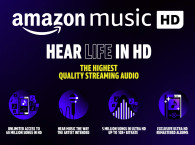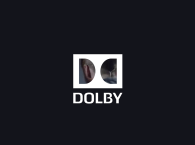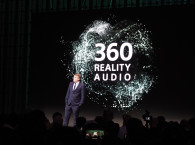
I couldn't help noticing that in the past few years, and in particular the past three years of the International AES convention in New York, the exhibition has been somehow inconsistent, with many exhibitors doing once-in-a-while appearances, which is a shame. The space arrangement this year was clever, clearly disguising the fact that there were less large booths and slightly less exhibitors (and unfortunately a few empty booths as well...) with the different presentation stages and special exhibits positioned in order to provide a better flow of visitors and better use of the hall space.
It is clear that the AES could benefit from a stronger promotion of the show itself, appealing to a wider range of companies and application segments, like radio, live sound, media production, and even consumer segments. In fact, even though the AES exhibition is predominantly focused on recording and studio technology, I have no idea why the AES sometimes calls it "Pro Audio Convention" - shouldn't the association reflect all segments of the audio industry? The conference itself covers topics in all the relevant audio application areas, from consumer and automotive applications, to gaming, virtual reality, music production or sound reinforcement, and even product development. It only seems logical that the exhibition should reflect the same interests.
Anyway, the event was vibrant and interesting and there were lots of different things to cover. We have already posted a few of the product announcements on the website - see our coverage here - and we will continue to expand some specific topics in the next two weeks. But clearly, the dominant topic for this 147th AES convention was the announcement made by the music industry, just before the event opened its doors.

360 Reality Audio
On Tuesday, October 15, in New York, Sony, together with four music streaming services and an important number of music industry partners promoted a press event to announce the new 360 Reality Audio music ecosystem. This follows the presentations made early this year at CES - which audioXpress covered here - and a repeat of the demonstrations at IFA 2019 in Berlin.
At this event, Sony announced the upcoming commercial availability of 360 Reality Audio, an immersive audio experience utilizing object-based spatial audio technology. "Beginning in Autumn 2019, listeners in Europe, the United States, and beyond can access approximately 1,000 songs in this new format from artists such as Mark Ronson and Pharrell Williams through streaming services Amazon Music HD, Deezer, nugs.net and TIDAL," the company confirmed. The services available first in the United States, and the United Kingdom, will expand to Germany and Japan later in 2019.
Since the concept was first introduced at CES 2019, Sony says that its 360 Reality Audio initiative has "generated broad and enthusiastic support among industry partners and artists who are eager to share its power." And they expanded the idea saying that "Object-based spatial audio technology makes it possible for artists and music creators to produce a music experience by mapping sound sources such as vocals, chorus, and instruments with positional information and placing them within a spherical space. When listeners hear content produced in the 360 Reality Audio music format, they experience an immersion into sound that closely mimics the omni-directional soundscape of a live musical performance."
For me, this seems to be a clever marketing idea to add some extra sparkle to the music industry's effort to evolve music streaming services and distribution to lossless and high-resolution audio (HRA) formats. And very specifically, this initiative, supported by Amazon's recent announcement of its FLAC-based Amazon Music HD top service tier, seems to be a way to attract the attention of mainstream consumers, to differentiate the standard existing stereo catalog. Even though the high-end audio and music enthusiast communities have already embraced HRA, the music majors know that the generic consumer would never be able to differentiate that higher-quality experience, so "something extra" was needed. And the idea their marketing departments came up with was to promote the immersive experience made possible by object-based spatial audio formats, specifically Dolby Atmos and MPEG-H.
To promote this gigantic effort, Sony is working with Sony Music Entertainment (its own music division), Universal Music Group and Warner Music Group, Live Nation, music distribution services, and other music organizations to provide the technology for building a musical ecosystem around 360 Reality Audio, which will include the creation, distribution and playing of music content. At the AES convention in New York, a day later, Sony had a 360 Reality Audio promotion booth, and provided further specifications about the music format with the cooperation of Fraunhofer IIS, responsible for the development of the MPEG-H audio specifications. "Through these efforts, Sony is working to promote this new music experience to music creators, artists and music fans, with the aim of creating an entirely new world of music entertainment," they stated.
Starting November 1, in Amazon Music HD, and later in Deezer, nugs.net and TIDAL, consumers will be able to access music content already formatted for those immersive experiences in Dolby Atmos and MPEG-H. Sony also confirmed it is working to expand the effort with other service providers, including Napster. Both Sony and Amazon confirmed that approximately 1,000 songs will be available November 1, including more than 100 special immersive recordings made during recent concerts and new popular tracks from major artist, especially remixed or produced in 360 Reality Audio.

How will this play out?
MPEG-H 3D Audio is an international open audio standard, and is optimized for music streaming, and Sony will now work to promote and expand the available content library and compatible audio devices moving forward. Playback of 360 Reality Audio content can also be enjoyed on mobile devices, soundbars, and a prototype for in-car immersive music playback was already demonstrated by Fraunhofer, Audi and Sony at the 2019 AES International Conference on Automotive Audio in September.
As Sony was explaining at the AES convention, "360 Reality Audio can be fully enjoyed on headphones and wireless speakers at service launch." In other words, any headphones combined with an Android/iOS smartphone that has a participating streaming services app installed. But if the user decides to use Sony's headphones (see models here) and the "Sony Headphones Connect" app, it will be possible to "enjoy a custom immersive musical field that is perfectly optimized for each individual user." This is done using an app that analyzes the listener's hearing characteristics from images of the ear - the app uploads the images of the ear profile to the cloud, compares to a database and sends the closest head-related transfer function (HRTF) profile, which is selected "leveraging Sony's unique algorithm." In Las Vegas, NV, during CES, Sony was actually measuring the user's ears with microphones to create the HRTFs, but now they use this generic solution - which for some people works reasonably well and for many others is just "meh..."
On the content side - an important message for the AES crowd - Sony is "working with studios to prepare a content creation environment" in the US and UK and "this list will be expanded over time." And more important, as anticipated, Sony is working in cooperation with Fraunhofer IIS, since the format is compliant with the MPEG-H 3D Audio open audio standard, and optimized for music streaming. As licensors, Sony and Fraunhofer IIS are working together to expand the available content library, participating streaming services and compatible audio devices moving forward. More on content format and licensing here.
If the user wants to hear the "immersive music" on speakers it will need "a speaker system with Sony's unique decoder of the 360 Reality Audio music format, multiple speaker units and signal processing technology. Moreover, Sony has also partnered with platform and chipset providers such as Google (Chromecast) and Amazon (Alexa), Media Tek, NXP Semiconductors, and Qualcomm, in order to make 360 Reality Audio usable "in a wide range of future connected devices."
The Amazon Echo Studio
Or... "Compatible songs can be played back from Amazon Music HD using Echo Studio." In fact, Amazon had a demo room at the AES convention running continuous demonstrations of its recently announced Echo Studio speaker. 360 Reality Audio on Amazon Music HD currently only plays on Echo Studio because the device needs to have a decoder. Read more about it here.

I attended the sessions twice and, like all other attendees, we all agreed that the Echo Studio sounded impressive - the 5.25-inch woofer was working really hard to fill the (large) room - but the sound was clearly localized and nothing similar to a Dolby Atmos or immersive audio experience. Coincidently, in the days prior to the AES I had visited Apple's flagship New York Fifth Avenue flagship store where they have a very nice room dedicated to the HomePod - with two areas equipped with paired speakers, allowing visitors to select the music and enjoy an impressively wide stereo result. I still had a good memory of those positive impressions from listening to the HomePods, and the (single) Echo Studio was in every way equally impressive. No doubt, Amazon will easily sell millions of these $199 speakers.
Of course, listening to "immersive music" was the focus at the AES demonstration and the effect of the front 1-inch tweeter and three surrounding 2-inch midrange speakers for the midrange and high frequencies accentuated the omnidirectional effect - but did not generate any obvious "tridimensionality" as it was described. One of the Amazon engineers presenting the demo even stated that having two Echo Studios would actually reinforce the "immersive effect." I couldn't help but compare it with the stereo sound generated by the two HomePods I heard earlier and wonder if the "single speaker" effect I was listening to wouldn't really be more convincing with two Echo Studios. Anyway, it was nothing even remotely close to what I have experience in fully equipped immersive audio rooms with multichannel configurations and ceiling speakers, or even in the Fraunhofer presentations with the impressive Sennheiser AMBEO soundbar.
I cannot help to wonder what the reaction from mainstream consumers will be when listening to streaming music in this new "magic format" with all the hype and the promises. Will they be impressed and convinced? In a way, they indirectly will be listening to purposely mastered material, available in high-resolution audio, which will always sound slightly different from the current stereo (and heavily compressed) experience. But will that be "the next big thing" as Sony, Amazon, and all the streaming services are promising?
This at least will be a good reason for Apple and Spotify to consider stepping up their game and move forward with an upgrade to their current compressed services. While they don't fear competition from Deezer, Tidal, or Qobuz, Amazon Music HD lossless FLAC streaming is an impressive service and promises to be a formidable competitor. These immersive formats will certainly generate a lot of attention from consumers - at the initial marketing stages. Together with the "immersive" 3D audio effect, Amazon places the ability to playback high-resolution audio (HRA) in the key selling points for the new Echo Studio smart speaker. And the support from the three majors is impressive.
Also, important not to forget that Dolby is placing all its marketing muscle behind its current Dolby Atmos Music Streaming promotion efforts - also working with Amazon. In my overview of the Dolby announcements, I wrote "Anyone who has recently watched a movie blockbuster in a modern cinema has certainly experienced and recognized the added emotional impact of a Dolby Atmos soundtrack. (...) Creating a similar experience on a large-size soundbar is possible using clever audio processing, but was never achieved from a compact omni-directional speaker array."
I just hope that all these initiatives and marketing ideas around Dolby Atmos Music and 360 Reality Audio don't blow-up in the faces of the companies involved, destroying the indisputable merits of "real" immersive audio and object-based audio formats. There's far too much at stake in all this.
This article was originally published in The Audio Voice email weekly newsletter, October 24 2019. Sign-up here.








